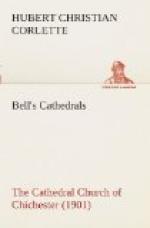The lowest part of the south-west tower presents a treatment different from that on the west side. There is here a doorway, and an additional window. Both are round-arched. The doorway is one of the most notable pieces of beautiful design on all the exterior of the building. It is treated solely with variations of the well-known chevron ornament. The cut work upon it is in no case at all deep, but the total effect is truly delightful. There is none of the dead, formal regularity invariable in modern attempts to imitate this type of work. The voussoirs of the arch are not all of equal size in each order, and on one member the chevrons are reversed on opposite sides of the centre stone except for one accidental intermission. The abacus, nearly six inches deep, has a flat upper part on which a continuous diaper of Greek crosses has been cut. The lower part is a plain, hollowed chamfer moulding. Though the small columns in the jambs are new, and also parts of the inner reveal of the jamb, yet the old carved capitals are still in position and also the bases. These capitals bear distinct traces of Byzantine feeling in the design of them. Above the doorway is a billet-moulded string-course, which stops against the circular shafts by the buttresses, and forms the sill of the window. The design of this opening is like that of the one over it in the next stage, which is similar to that in the same position on the west face of the tower. But the abaci of its capitals run from the jambs across to the buttresses, as is the case with those of the doorway. The billet-moulded sill evidently passed round the tower completely, before the addition of the angle buttresses, since it appears again on the north buttress of the west front of the same tower; and the obvious inference is that there was once a window also on the west in this same stage at the same level. The window immediately below the upper division of the tower is of the same date and character exactly as the one on the west in the like place; and it should be noticed that the sills of the upper windows run on as string-courses, which are continued round the circular angle-shafts of the buttresses.
Passing eastward from the tower, the external #Roof# of the nave becomes visible. The irregularly waved line of the ridge where the lead rolls meet, as it were, against the sky, is a pretty indication of the presence of the aged timbers underneath that support it above the walls.
The oldest part of the building to be seen from this point is the strip of walling at the clerestory level. The twelfth-century round-arched windows are there almost complete. In detail they are like those of the tower. Two of them, those in the fourth and fifth bays from the tower, have had later work inserted in the same openings.




